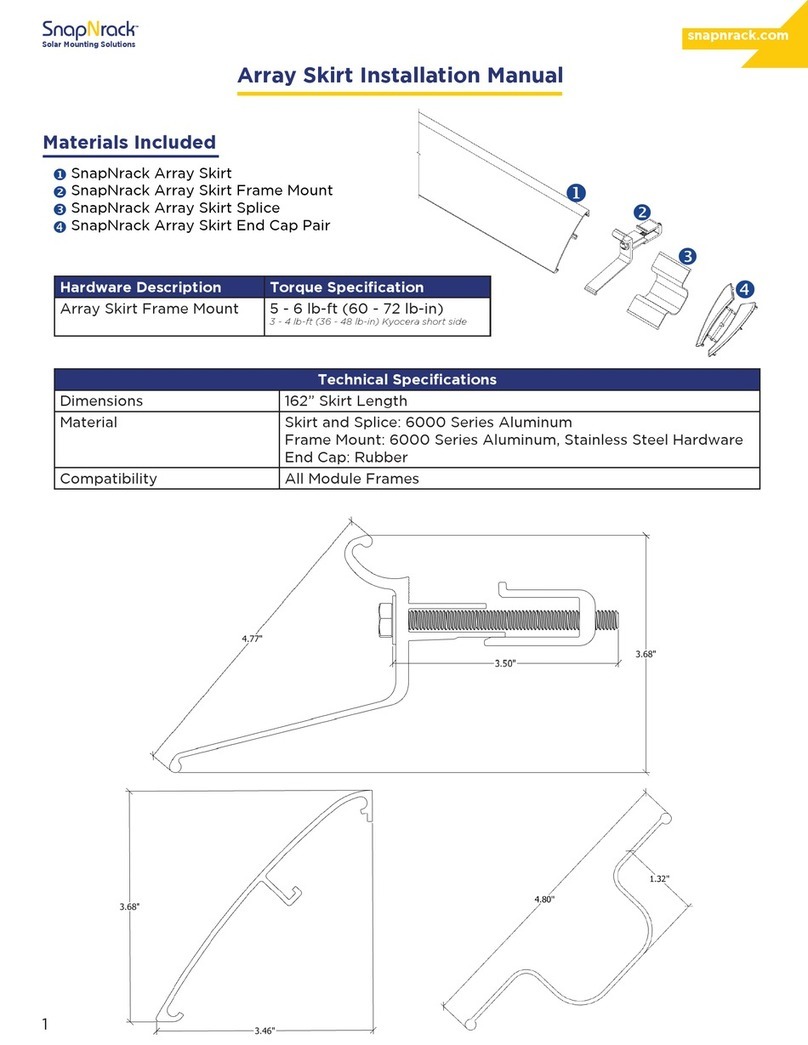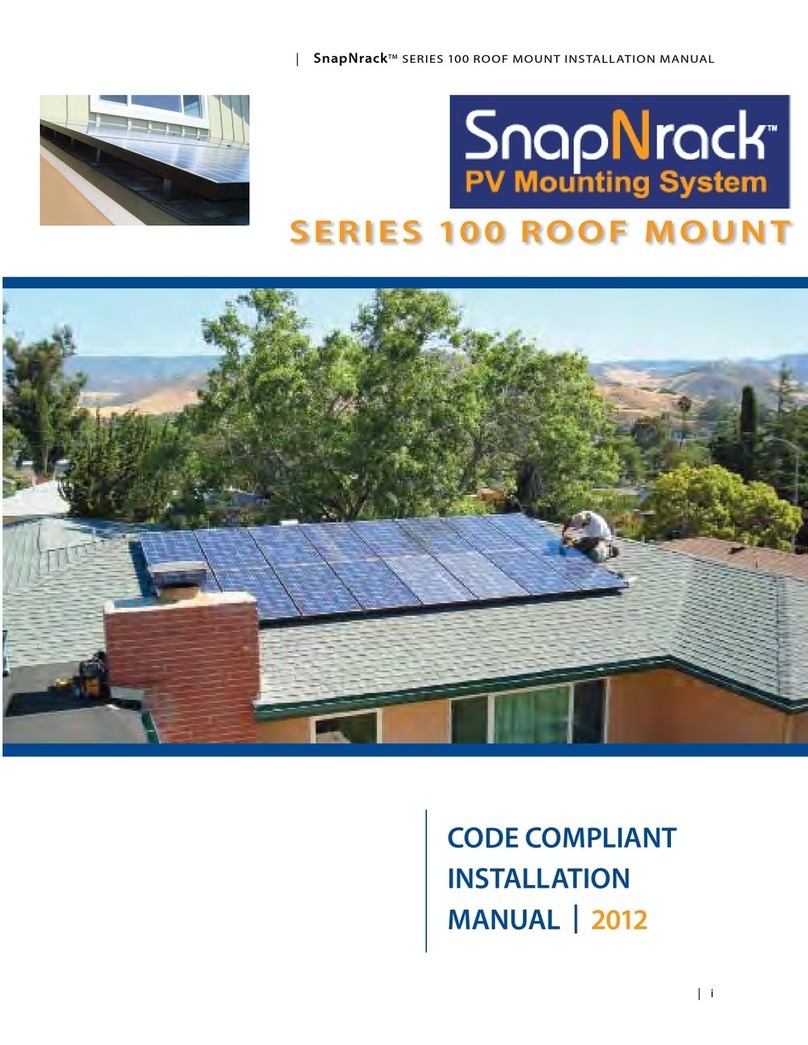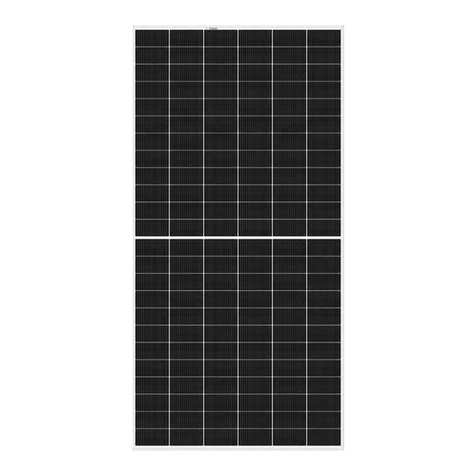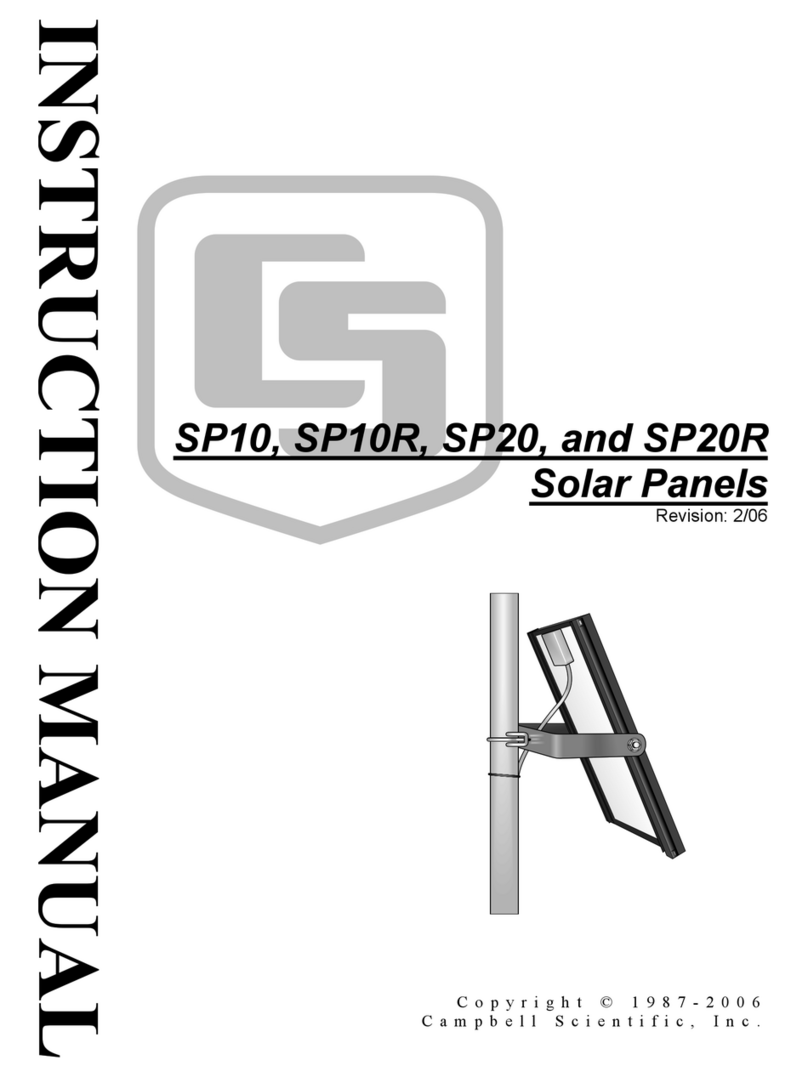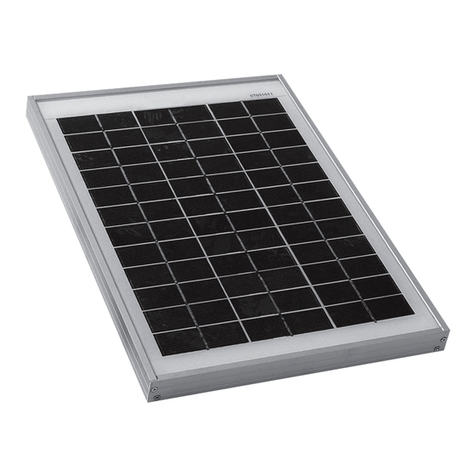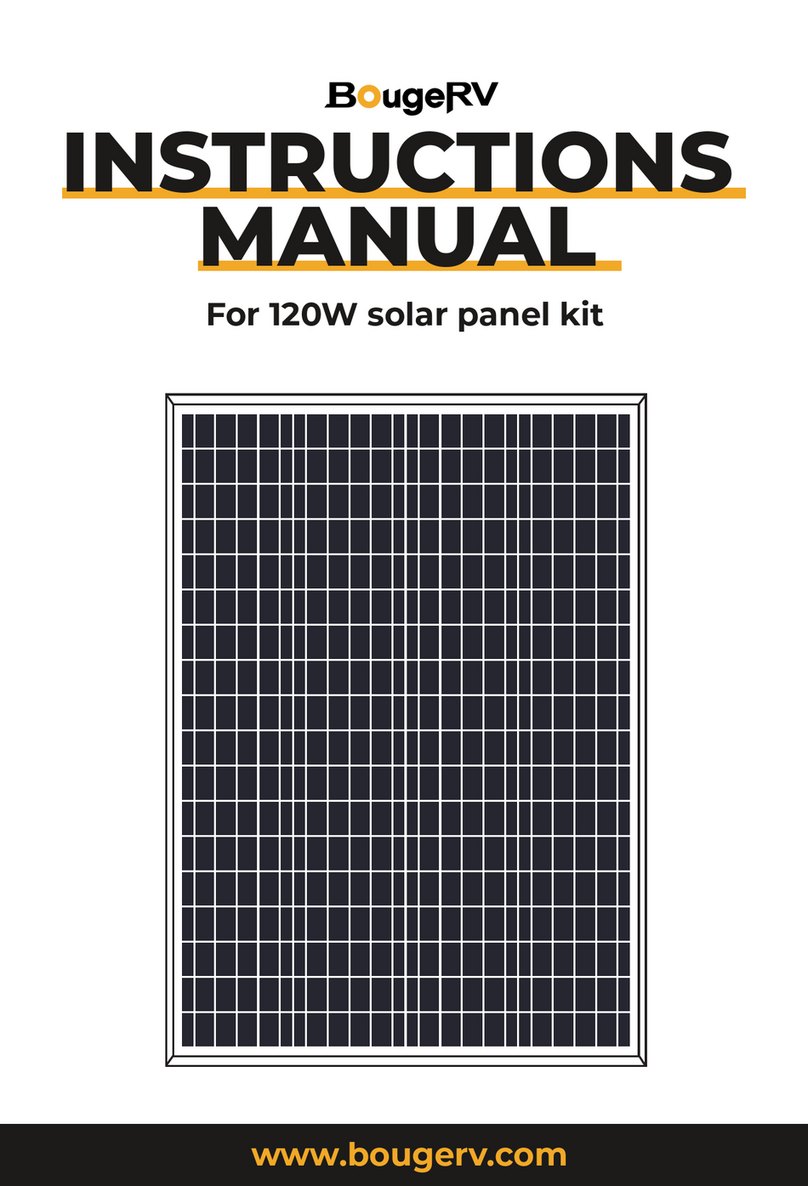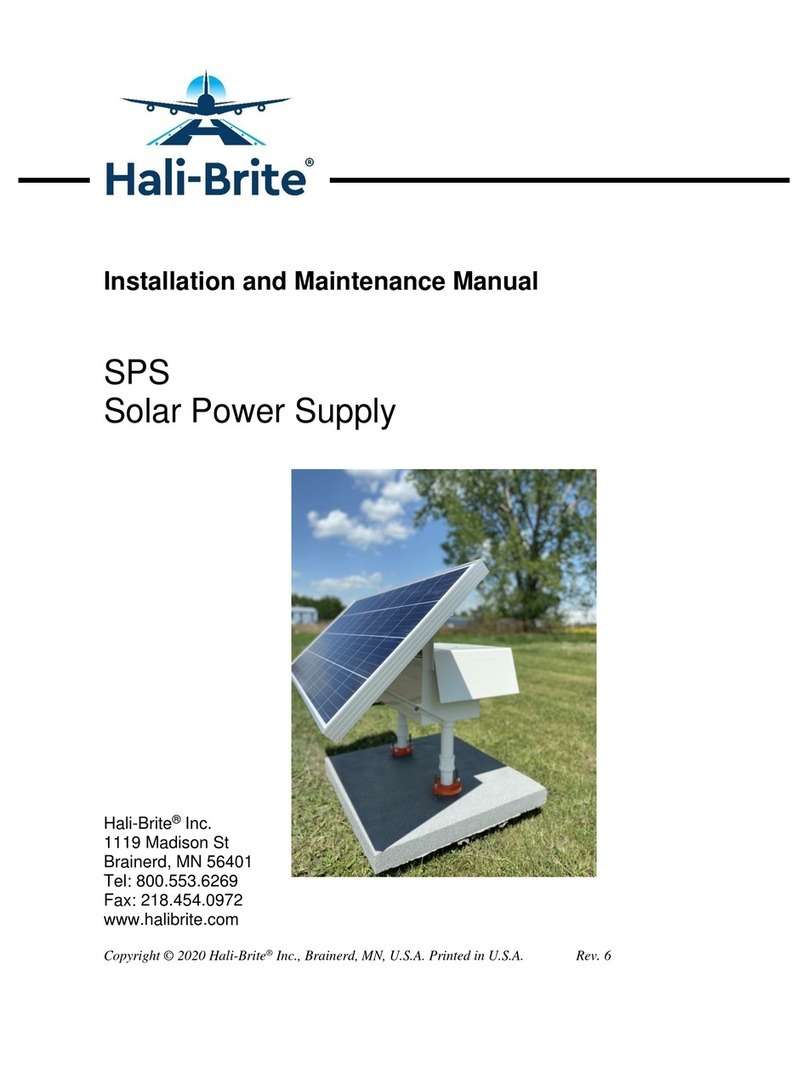SnapNrack Series 100 UL User manual

1
PV Mounting System
2703
SERIES 100 UL
ROOF MOUNT SYSTEM
Code Compliant Installation Manual
SnapNrack Solar Mounting Solutions

2
Series 100 UL Introduction
SnapNrack Series 100 UL PV Mounting System oers a low profile,
visually appealing, photovoltaic (PV) module installation system. This innovative
system simplifies the process of installing solar PV modules, shortens installation
times, and lowers installation costs.
SnapNrack systems, when installed in accordance with this manual, will be
structurally adequate for the specific installation site and will meet the local
and International Building Code. Systems will also be bonded to ground, under
SnapNrack's UL 2703 Certification.
The SnapNrack installation system is a set of engineered components that can
be assembled into a wide variety of PV mounting structures. It is designed to be
installed by qualified solar installation technicians. With SnapNrack you will be
able to solve virtually any PV module mounting challenge.
Table of Contents
Step 1: Project Plans
Configuration . . . . . . . . . . . . . . . . . . . . . . . . . . . . . . . . . . . . . . . . . . . . . . . 3
Surveying and Layout. . . . . . . . . . . . . . . . . . . . . . . . . . . . . . . . . . . . . . . . . 4
Step 2: Roof Attachment
Flashed L-Foot- For Composition Shingle . . . . . . . . . . . . . . . . . . . . . . . . 6
Standoff Post- For All Roofing Types . . . . . . . . . . . . . . . . . . . . . . . . . . . . 8
Standoff Options . . . . . . . . . . . . . . . . . . . . . . . . . . . . . . . . . . . . . . . . . . . 10
Universal Tile Roof Hook . . . . . . . . . . . . . . . . . . . . . . . . . . . . . . . . . . . . . 12
Flat Tile Roof Hook. . . . . . . . . . . . . . . . . . . . . . . . . . . . . . . . . . . . . . . . . . 14
Hanger Bolt- For All Roofing Types . . . . . . . . . . . . . . . . . . . . . . . . . . . . 17
Metal Roof Base . . . . . . . . . . . . . . . . . . . . . . . . . . . . . . . . . . . . . . . . . . . . 19
Corrugated Roof Block- For Corrugated Metal . . . . . . . . . . . . . . . . . . . 21
Tilt Mount 5°-15° . . . . . . . . . . . . . . . . . . . . . . . . . . . . . . . . . . . . . . . . . . . . 23
Tilt Mount 10°-45°. . . . . . . . . . . . . . . . . . . . . . . . . . . . . . . . . . . . . . . . . . . 25
Seam Clamp- For Standing Metal Seam . . . . . . . . . . . . . . . . . . . . . . . . . 27
Step 3: Leveling Rails
Installing and Leveling Rails . . . . . . . . . . . . . . . . . . . . . . . . . . . . . . . . . . 29
Step 4: Attaching Modules
Attaching Modules . . . . . . . . . . . . . . . . . . . . . . . . . . . . . . . . . . . . . . . . . . 31
Step 5: Select Any Racking Accessories
Edge Screen . . . . . . . . . . . . . . . . . . . . . . . . . . . . . . . . . . . . . . . . . . . . . . . 33
Wire Management. . . . . . . . . . . . . . . . . . . . . . . . . . . . . . . . . . . . . . . . . . . 35
Micro inverter Attachment. . . . . . . . . . . . . . . . . . . . . . . . . . . . . . . . . . . . 37
System Ground
System Ground . . . . . . . . . . . . . . . . . . . . . . . . . . . . . . . . . . . . . . . . . . . . . 39
Rail Cutting Tool and End Cap . . . . . . . . . . . . . . . . . . . . . . . . . . . . . . . . 41
High Tilt Tool
High Tilt Tool. . . . . . . . . . . . . . . . . . . . . . . . . . . . . . . . . . . . . . . . . . . . . . . 43
Appendix . . . . . . . . . . . . . . . . . . . . . . . . . . . . . . . . . . . . . . . . . . . . . . . . . . . 45
Series 100 UL
Intro/Configuration
Step 1: Project Design and
System Configuration

MODULE OVERHANG
(NOT TO EXCEED 25%
OF MODULE LENGTH)
RAIL SPAN
RAIL END OVERHANG
(NOT TO EXCEED 34% OF
ACCEPTABLE RAIL SPAN)
Building Height 0 - 30 ft
Array Pitch 16°
2012 IBC Wind Speed 120 mph
Snow Load 8 lbs/ft
Topo. Cond. None
Rail Span 104"
Rail Span on 24" spacing roof 96" (8 ft)
Do edge/corner reductions apply Yes, shaded cell
Edge Zone Span 72" (6 ft)
Corner Zone Span 24" (2 ft)
3
Safety Guidance
- Always wear the proper OSHA approved
safety equipment when working on a roof .
- Safety equipment should be checked
annually for wear and quality.
- Always wear proper eye protection.
- When walking on the roof avoid walking
on installed rails. If this is unavoidable check
L-feet for fatigue before final installation.
- Appropriate fall protection gear should
be used. Extreme caution should be
used when near the edge of the roof.
Series 100 UL
Roof Mounted System
How to Configure Your System
First calculate the spans and penetration count. See span
tables in structured engineering letters under the resources
tab of the SnapNrack website. Determine site conditions:
general building height, array pitch, the wind speed, and
snow load or topographical condition. Find appropriate
railspan from table.
Span Table Example
*CS-Consult
Structural Engineer Notes
- The UL Listing covers bonding
for a load rating up to 45 psf.
- See Appendix A for the list of modules
that have been tested with the Series 100
UL system.
- These systems have been evaluated
for module to system bonding, only to
the requirements of UL Subject 270.
- This system has also been
evaluated for a Class A System Fire
Classification for a steep-sloped roof
with Type 1 and Type 2 modules.
- Installing Contractor is responsible for
verification that attachments to roof
framing are fully engaged into appropriate
structural member and that structural
member is adequate for support of roof
mounting component and associated loads.

4
Survey the Site
Measure the roof surfaces and develop an accurate drawing, including
any obstacles such as chimneys and roof vents.
If plans are available, check to make sure that the plans match the final
structure.
Review the shading pattern across the roof surface from the residence itself,
from adjacent structures, and from other nearby features such as trees.
Identify any roof access areas or keep-out areas as required by the local
jurisdiction.
Confirm roof construction, type, and condition.
Assess roof rafter size, material, and spacing to confirm that the structure is
sound and can support the additional load of the array.
Identify any construction anomalies that may complicate the process of
locating rafters from the roof surface.
If you find structural problems such as termite damage or cracked rafters
that may compromise the structure’s integrity, consult a structural engineer.
Develop a Layout
Using the information collected in the site survey and from the span tables, complete a
system layout showing array location and distances from key roof features. Include
any information necessary for the permitting process.
Typically, PV modules are installed in portrait mode, with the long side of the
module running up the roof slope and the rails running horizontally across the roof
perpendicular to the roof rafters, which commonly run down slope.
PORTRAIT MODE LANDSCAPE MODE
MODULE LENGTH
MODULE WIDTH
Series 100 UL
Surveying and Layout

5
Notes
- SnapNrack engineered systems should
only be used with SnapNrack components
and hardware. Any alternate application
may void the warranty and structural
calculations could become invalid.
Tips and Tricks
- Layout the entire array on the roof by
drawing all of the corners of the modules
on the roof with a roof marking crayon.
- Use a chalk line to help identify
the rest of the roof penetrations
- When leveling rails, hand tighten the
hardware to easily level and position
the rails. Once rails are level, fully
tighten hardware to specified torque.
Series 100 UL
Surveying and Layout
Arrays can also be installed in landscape mode, with the
modules oriented so that their long edge runs horizontally
across the roof and the rails run up the roof slope. Landscape
mode is typically used in cases where the roof has been
constructed with structural elements running horizontally
across the roof, but can also be used on standard residential
buildings for a variety of reasons including to facilitate a
convenient layout. When laying out the array, be sure to leave
space for the module clamps on the rails. Module mid clamps
are installed between modules in a row and require 0.5"
of space between the modules.
Adjustable end clamps require 1.5" of extra rail to extend
past the end of the module frame. If using the Universal End
Clamp, the rail is first cut flush to the module using the rail
cutting tool.
When installing multiple rows of modules, a minimum
spacing gap of 1/8" should be used between rows.
Submit array plans to local permitting jurisdiction and
proceed with the roof layout only when all permits for
the project have been granted by the authority having
jurisdiction.
Transfer the array layout to the roof using a roof marking
crayon to mark the inside and outside corners of the array.
Locate the estimated rafter positions and mark them in the
array area with a roof marking crayon.
Transfer rail and estimated attachment locations to the roof,
noting that attachments will be located at intersections of
rails and rafters. Layout rails such that module frame ends
do not overhang mounting rails by more than 25% of total
module length.
Project Information Sections
Building Height
Roof Pitch
Wind Speed
Snow Load
Topo. Cond. Max Rail Span
Roof Structure Type
Roof Structure Size
Roof Structure Span
Roof Type & Condition
Stories from the Ground
Roof Orientation

6
Required Tools:
Materials Included in Series 100 L-Foot Kit:
Other Materials Required:
Technical L-Foot Data:
Dimensioned Assembly
Dimensioned
L-Foot
(1) SnapNrack Flashed Base
(1) SnapNrack Composition Flashing
(1) SnapNrack L Foot, Composition 92°
(1) 5/16" - 18 SS Flange Hex Nut
(1) 5/16" Flange Bolt
(1) SnapNrack Bonding Channel Nut, 5/16" - 18
Material 6000 Series Heat Treated Aluminum
Finish Class 2 Anodized Finish
Clear and Black Finish Available
Weight 0.16 LBS
Design Uplift Load 200 LBS Uplift
Design Ultimate Load 1000 LBS Uplift
Hammer Or Stud Finder
Roof Marking Crayon
Drill with 1/8" Pilot Drill Bit
Roof Sealant
Torque Driver with Bit Adapter
1/2" Socket Wrench or Impact
Driver
(1) 5/16" Lag Screw
(1) 5/16" Washer
When To Use:
Composite Shingle Roofs
3"
1-1/2"
1-3/4"
92°
12"
4"
31
2"
1"
1
2"
Step 2: Install Roof
Attachment
Series 100 UL
Flashed L-Foot

7
Series 100 UL
Flashed L-Foot
Design Tools
- SnapNrack has a suite of design tools
to help configure your PV installation to
be an accurate and fast install. Please
visit us at: www.SnapNrack.com.
Warning
- If a pilot hole is drilled and a rafter is not
found, immediately seal pilot hole with
roofing sealant to avoid water damage.
- Do not over tighten hardware.
- Always wear fall protection
and safety gear.
Notes
- Alternative 90° L Foot included
in UL 270 Listing
- SnapNrack engineered systems should
only be used with SnapNrack components
and hardware. Any alternate application
may void the warranty and structural
calculations could become invalid.
Step-by-Step Instructions
1) Locate the rafter underneath
the decking of the roof by looking
underneath the eaves or in the attic.
2) Drill a pilot hole through the
roofing material into the rafter to
ensure that the lag bolt will be located
into a solid portion of the rafter. If the
rafter is not found then seal the pilot
hole immediately with roofing sealant.
) Apply roofing sealant to
the bottom of the base and
directly onto the lag bolt to
ensure a water tight seal.
4) Attach the L-foot base with
a 5/16” lag bolt and a minimum
embedment of 2 ½” lag shank
into the rafter. Tighten Lag bolt
to seat with a hand wrench.
5) Slide the flashing underneath
the row of shingles, directly
above the installed standard base,
and then line up the hole in the
flashing with the threads on the
base. It may be necessary to pry
up shingles with a breaker bar.
6) Attach the L-foot to the threaded
portion of the base that is protruding
from the flashing. Then tighten
the flange bolt over the threads
to 10 – 16 ft-lbs. The L-foot can
be attached in any orientation.
1) Locate the rafter 2) Drill the pilot hole
3) Prep the base 4) Attach base
5) Set the flashing 6) Attach L-Foot

5-1/2"
7"
8-1/2"
1"
5/16"-18
10"
8
3-1/2"
7-1/2"
1"
1-1/2"
1-1/2"
1/2"
Required Tools:
Technical Stando Shaft Data:
Dimensioned Assembly Dimensioned Shaft
Materials Included In Series 100 Stando Kit:
Other Materials Required:
(1) SnapNrack Stando Base
(1) SnapNrack Stando Shaft
(1) SnapNrack Rubber Rain Collar
(1) SnapNrack Stando Clamp
(1) 5/16" SS Split Lock Washer
(1) 5/16" - 18 X 2in SS HCS Bolt
(1) SnapNrack Bonding Channel Nut, 5/16" - 18
(1) 5/16" Lag Screw
(1) 5/16" Washer
(1) Roof Cone Flashing
Material 6000 Series Heat
Treated Aluminum
Finish Mill
Weight 5.5” Shaft = 0.4 LBS
7” Shaft = 0.5 LBS
8.5” Shaft = 0.6 LBS
Design Uplift Load 200 LBS Uplift
Design Ultimate Load 1600 LBS Uplift
Hammer or Stud Finder
Roof Marking Crayon
Drill with 1/8" Pilot Drill Bit
Roof Sealant
Torque Driver with Bit Adapter
Channel Locks
1/2" Socket Wrench
When To Use:
Concrete or Clay Tile Roofs
All Stando shafts
are mill finished
Series 100 UL
Stando Post

9
1) Remove tile and
locate the rafter
3) Prep the base and
attach base
5) Attach post 6) Replace tile and
attach stando clamp
4) Set flashing
2) Drill pilot hole
Series 100 UL
Stando Post
Design Tools
- SnapNrack has a suite of design tools
to help configure your PV installation to
be an accurate and fast install. Please
visit us at: www.SnapNrack.com.
Warning
- If a pilot hole is drilled and a rafter is not
found, immediately seal pilot hole with
roofing sealant to avoid water damage.
- Do not over tighten hardware.
- Always wear fall protection
and safety gear.
Notes
- SnapNrack engineered systems should
only be used with SnapNrack components
and hardware. Any alternate application
may void the warranty and structural
calculations could become invalid.
Step-by-Step Instructions
1) Remove roof tile where the
penetration will be installed. Locate
the rafter underneath the decking
of the roof by locating under the
eave, in the attic, or by tapping
the roof surface with a hammer.
2) Drill a pilot hole through the roofing
material into the rafter to ensure that
the lag bolt will be located into a solid
portion of the rafter. If the rafter is
not found then seal the pilot hole
immediately with roofing sealant.
) Apply roofing sealant to the bottom
of the base and directly onto the
lag bolt to ensure a water tight seal.
Attach the Stando base with a 5/16”
lag bolt and a minimum embedment of
2 ½” lag shank into the rafter. Tighten
lag bolt to seat using a hand wrench.
4) Set the flashing by sliding the
flashing underneath the row of tiles
directly above the installed base, with
the hole in the flashing directly above
the threaded portion of the base.
5) Attach the stando shaft by
sliding it through the hole in the
flashing and tightening it onto
the threads protruding from the
base snug with channel locks.
6) Cut the tile to fit around the
flashing, replace the tile, then attach
the stando clamp by first sliding the
rubber rain collar over the stando
shaft then the stando clamp with
bolt, washer and channel nut.

10
Materials Included In Series 100 Stando Kit
(Steel Structural Member):
Other Materials Required:
(1) SnapNrack Stando Base
(1) SnapNrack Stando Shaft
(1) SnapNrack Rubber Rain Collar
(1) SnapNrack Stando Clamp
(1) 5/16" SS Split Lock Washer
(1) 5/16" - 18 X 2" SS HCS Bolt
(1) SnapNrack Bonding Channel Nut, 5/16" - 18
(1) 1/4" Tek Screw
(1) Roof Cone Flashing
Materials Included In Series 100
Four Hole Stando Kit:
Other Materials Required:
(1) SnapNrack Four Hole Stando Base
(1) SnapNrack Stando Shaft
(1) SnapNrack Rubber Rain Collar
(1) SnapNrack Stando Clamp
(1) 5/16" SS Split Lock Washer
(1) 5/16" 18 X 2" SS HCS Bolt
(1) SnapNrack Bonding Channel Nut, 5/16" - 18
(4) Wood Screws 1/4"
(1) Roof Cone Flashing
When To Use:
Steel Structural
Member Configurations
When To Use:
Composite
Wood I-Joists
Standard Stando Base
Four Hole Stando Base
Series 100 UL
Stando Options

11
Materials Included In Series
100 Heavy Duty Stando Kit:
Other Materials Required:
(1) SnapNrack HD Stando Base
(1) SnapNrack HD Stando Shaft
(1) SnapNrack Rubber Rain Collar
(1) SnapNrack Stando Clamp
(1) 5/16in SS Split Lock Washer
(1) 5/16" - 18 X 2" SS HCS Bolt
(1) SnapNrack Bonding Channel Nut,
5/16" - 18
(2) 5/16" Lag Screw
(1) Roof Cone Flashing
Series 100 UL
Stando Options
Design Tools
- SnapNrack has a suite of design tools
to help configure your PV installation to
be an accurate and fast install. Please
visit us at: www.SnapNrack.com.
Warning
- If a pilot hole is drilled and a rafter is not
found, immediately seal pilot hole with
roofing sealant to avoid water damage.
- Do not over tighten hardware.
- Always wear fall protection
and safety gear.
Notes
- SnapNrack engineered systems should
only be used with SnapNrack components
and hardware. Any alternate application
may void the warranty and structural
calculations could become invalid.
- Installing Contractor is responsible for
verification that attachments to roof
framing are fully engaged into appropriate
structural member and that structural
member is adequate for support of roof
mounting component and associated loads
Step-by-Step Instructions For
Zee Purlin Installation
1) Follow the instruction exactly
as the SnapNrack Stando
penetration. Substituting the tek
Screw for the 5/16” lag bolt.
Step-by-Step Instructions For
Four Hole Installation
1) Follow the instruction exactly as the
SnapNrack regular Stando penetration.
Substituting the base for the four hole base
and 1/4" wood screws for the 5/16” lag bolt.
Step-by-Step Instructions For
Heavy Duty Installation
1) Remove the foam roofing above
the rafter to be installed on.
2) Attach the SnapNrack heavy duty
stando base directly to the exposed
rafter using (2) 5/16” lag bolts.
) Screw in the SnapNrack HD Stando
to the base snug with channel locks.
4) Replace the foam roofing
that was removed.
5) Flash the stando by sliding the cone
flashing over the exposed stando and
heat weld the rubber membrane around
the flashing for a water tight seat.
6) Attach remaining hardware as in
the standard SnapNrack stando.
When To Use:
Foam Roofs
HD Base

12
Material 6000 Series Heat Treated Aluminum Base
304 Stainless Steel Arm
Finish Mill Finish Base
Bare Metal Arm
Weight 2 lbs
Design Uplift Load 175 lbs
Design Ultimate Load 650 lbs
Required Tools:
Hammer or Stud Finder
Roof Marking Crayon
Drill with 1/8" Pilot Drill Bit
Roof Sealant
Torque Driver with Bit Adapter
1/2" Socket Wrench or impact driver
Flat Pry Bar
Materials Included In Universal Tile Roof Hook:
(1) SnapNrack Universal Tile Roof Hook Base
(1) SnapNrack Universal Tile Roof Hook Arm
(2) 5/16" Flange Bolt
(2) SnapNrack Bonding Channel Nut, 5/16" - 18
Other Materials Required:
(2) 5/16" Lag Screw
(2) 5/16" Washer
Roof Felt of Flexible Flashing (when
required for deck-level flashing)
8
.
0
0
7
.
2
5
8
.
80
8
.
0
0
7
.
2
5
8
.
80
Dimensioned Assembly:
Technical Universal Tile Roof Hook Data:
When To Use:
Flat, Wave and S Style
Concrete Tile Roofs
Series 100 UL
Tile Roof Options

1) Locate the rafter
3) Install Tile Hook base
2) Drill pilot holes
4) Position Tile Hook arm
5) Work channel nut into
groove
6) Attach Tile Hook arm
to base
7) Optional deck-level
flashing
8) Replace tile and install
rail
13
Series 100 UL
Universal Tile Roof Hook
Notes
- SnapNrack engineered systems
should only be installed with SnapNrack
components and hardware. Any alternate
application may void the warranty,
the UL 270 Listing, and the structural
calculations may no longer be valid.
Step-by-Step Instructions
1) Use pry bar to remove roof tile
where the base will be installed.
Locate the rafter underneath the
decking of the roof by locating under
the eave, in the attic, or by tapping
the roof surface with a hammer.
2) Align the base over the rafter so
the hook can enter at the valley of
a tile and not extend beyond the
edge of the base. Drill two pilot
holes in the center of the rafter. If
the rafter is not found then seal the
pilot hole immediately with sealant.
) Apply roofing sealant to the bottom
of the base and directly onto each
lag screw. Attach the base with two
5/16” lag screws with washers at a
minimum 2 ½” lag shank embedment
into the rafter. Tighten the lag screw
to seat using a hand wrench.
4) Insert the top end of the arm into
the groove at the top of the base. The
arm will move freely in the base until
the channel nut is tightened. Position
the arm over the valley of the tile
below, then lower the arm down.
5) As you lower the arm you can
work the channel nut into the
lower groove of the base without
removing the channel nut.
6) Ensure the hook is aligned with
the valley of the tile. Tighten the bolt
in the channel nut and be sure the
arm fully seats to the base. The arm
will work in any position on the base
independent of the lag screw location.
7) If deck-level flashing is required,
integrate roof felt or a flexible flashing
with the existing underlayment
and over the Tile Hook.
8) Replace the roof tiles and
install SnapNrack Standard Rail
directly to the available channel
nut on the Tile Hook arm.

14
Required Tools:
Hammer or Stud Finder
Roof Marking Crayon
Drill with 1/8" Pilot Drill Bit
Roof Sealant
Torque Driver with Bit Adapter
1/2" Socket Wrench or impact driver
Flat Pry Bar
Materials Included In Flat Tile Roof Hook:
(1) SnapNrack Flat Tile Hook
(1) 5/16" Flange Bolt
(1) SnapNrack Bonding Channel Nut, 5/16" - 18
Other Materials Required:
(2) 5/16" Lag Screw
(2) 5/16" Washer
Roof Felt of Flexible Flashing (when
required for deck-level flashing)
Material 304 Stainless Steel
Finish Bare Metal
Weight 1.2 lbs
Design Uplift Load 175 lbs
Design Ultimate Load 650 lbs
Technical Flat Tile Roof Hook Data:
6
.
1
9
1
.
2
5
8
.
7
8
6
.
1
9
1
.
2
5
8
.
7
8
Dimensioned Flat Tile Roof Hook:
When To Use:
Flat Concrete
Tile Roofs
Series 100 UL
Tile Roof Options

1) Locate the rafter
3) Install Tile Hook
2) Drill pilot holes
4) Optional deck-level
flashing
5) Replace tile and install
rail
15
Series 100 UL
Flat Tile Roof Hook
Design Tools
- SnapNrack has a suite of design tools
to help configure your PV system to be
an accurate and fast installation. Please
visit us at: www.SnapNrack.com.
Warning
- If a pilot hole is drilled and a rafter is not
found, immediately seal pilot hole with
roofing sealant to avoid water damage.
- Do not over tighten hardware.
- Always wear fall protection
and safety gear.
Notes
- SnapNrack engineered systems
should only be installed with SnapNrack
components and hardware. Any alternate
application may void the warranty,
the UL 270 Listing, and the structural
calculations may no longer be valid.
Step-by-Step Instructions
1) Use pry bar to remove roof tile
where the Tile Hook will be installed.
Locate the rafter underneath the
decking of the roof by locating under
the eave, in the attic, or by tapping
the roof surface with a hammer.
2) Align the Tile Hook over the
rafter and drill two pilot holes in
the center of the rafter. If the rafter
is not found then seal the pilot
hole immediately with sealant.
) Apply roofing sealant to the bottom
of the Tile Hook and directly onto each
lag screw. Attach the base with two
5/16” lag screws with washers with a
minimum 2 ½” lag shank embedment
into the rafter. Tighten the lag screw
to seat using a hand wrench.
4) If deck-level flashing is required,
install a flexible flashing over the Tile
Hook. See Flat Tile Roof Hook – Deck-
Level Flashing section for more details.
5) Replace the roof tiles and
install SnapNrack Standard Rail
directly to the available channel
nut on the Tile Hook arm.

1) Prepare underlayment
3) Apply flashing
2) Peel o backing
4) Roll flashing
5) Peel o backing 6) Roll strip
16
Series 100 UL
Flat Tile Roof Hook
Optional Deck-Level Flashing
Notes
- SnapNrack recommends testing
underlayment surfaces for adhesion. If
adhesion is found to be marginal, then
a primer is recommended to ensure
optimal adhesion. Refer to flexible
flashing manufacturer’s technical
data for primer recommendations.
- SnapNrack recommends using
Protecto Wrap Protecto Seal
45 waterproofing membrane,
or equivalent, as the flexible
flashing and lap material.
Step-by-Step Instructions
1) Prepare the underlayment surface
for adhesion. The surface should be
dry, clean and free of any dirt, dust
or foreign matter that may prevent
adhesion. Clean the surface around the
Tile Hook with a brush of medium-sti
bristles. If necessary, prime the surface
with compatible spray or paint primer.
2) Peel o the backing from a
9-in. square of flexible flashing.
) Apply flexible flashing centered
laterally over tile hook and abutted
to the tile hook arm. Ensure tape
adheres to the corners between
the edges of the Tile Hook and the
underlayment as well as over the lag
screw heads and tile hook surface.
4) Press and smooth out any creases
or air bubbles with a roller to maximize
contact of the flashing adhesive to
100% of the surface and Tile Hook.
5) Peel o the backing from a 4-in.
by 1" strip of flexible flashing.
6) Apply the strip with 2" laps at the
top and side edges of the square
flashing. Roll out any creases or air
bubbles between the strip, the flashing
and the underlayment surface.

3/8"
3/4"
1-1/2"
8" TYP 1-1/2"
3/4"
1"
R 0.188"
R 0.17"
17
Required Tools:
Materials Included In Series 100 Hanger Bolt Kit:
Dimensioned Assembly
Technical Hanger Bolt Clamp Data:
Dimensioned Hanger
Bolt Clamp
(1) 3/8” Stainless Steel Hanger Bolt
(1) SnapNrack Hanger Bolt Clamp Front
(1) SnapNrack Hanger Bolt Clamp Back
(1) 5/16" SS Split Lock Washer
(1) 5/16" - 18 X 1in SS HCS Bolt
(1) SnapNrack Bonding Channel Nut,
5/16" - 18
Material 6000 Series Heat
Treated Aluminum
Color Class 2 Anodized Finish
Clear Finish Available
Weight 0.7 LBS
Design Uplift Load 200 LBS Uplift
Design Ultimate Load 1600 LBS Uplift
Hammer or Stud Finder
Roof Marking Crayon
Drill with 1/8" Pilot Drill Bit
Roof Sealant
Threaded Bit Adapter
1/2" Socket Wrench or impact driver
Torque Wrench
When To Use:
Any Roof Style
Other Materials Required:
Series 100 UL
Hanger Bolt

18
1) Locate the rafter
3) Prep the bolt and hole
5) Set hanger bolt clamp
in rail
2) Drill the pilot hole
4) Install hanger bolt
6) Attach hanger bolt
clamp to hanger bolt
Series 100 UL
Hanger Bolt
Design Tools
- SnapNrack has a suite of design tools
to help configure your PV installation to
be an accurate and fast install. Please
visit us at: www.SnapNrack.com.
Warning
- If a pilot hole is drilled and a rafter is not
found, immediately seal pilot hole with
roofing sealant to avoid water damage.
- Do not over tighten hardware.
- Always wear fall protection
and safety gear.
Notes
- SnapNrack engineered systems should
only be used with SnapNrack components
and hardware. Any alternate application
may void the warranty and structural
calculations could become invalid.
Step-by-Step Instructions
1) Locate the rafter underneath
the decking of the roof.
2) Drill a pilot hole through the roofing
material into the rafter to ensure that
the lag bolt will be located into a
solid portion of the rafter. If the rafter
is not found then seal the pilot hole
immediately with roofing sealant.
) Apply roofing sealant directly onto
the pilot hole and the hanger bolt
lag to ensure a water tight seal.
4) Attach the hanger bolt using the
threaded bit adapter with a minimum
embedment of 2 ½” lag shank into the
rafter. Tighten Lag bolt to seat.
5) Attach the channel nut of the
hanger bolt assembly into rail.
6) Then attach the hanger bolt clamp by
setting it around the threaded portion
of the hanger bolt to the desired height
and tighten silver hardware to 10-16 ft-
lbs and black hardware to 8-10 ft-lbs.

19
Required Tools:
Materials Included In Metal Roof Base:
Dimensioned Assembly
(1) SnapNrack Metal Roof Base
(1) SnapNrack L Foot 90 degree
(1) 5/16" - 18 SS Flange Nut
(1) SnapNrack Bonding Channel Nut, 5/16" - 18
(1) 5/16" - Flange Bolt
Series 100 UL
Metal Roof Base
Hammer Or Stud Finder
Roof Marking Crayon
Drill with 3/16" Pilot Drill Bit
Torque Driver with Bit Adapter
1/2" Socket Wrench or impact
driver
Material 6000 Series Aluminum
Color Clear Anodized Aluminum
Weight 0.4 LBS
Design Uplift Load 1,008 LBS Uplift
Design Ultimate Load 4,033 LBS Uplift
Technical Metal Roof Base Data:
When To Use:
Metal Roof
Profiles
Use With:
Anodized
Aluminum L-Foot
and Flange Bolt
(1) 5/16” Lag Screw or 1/4” Tek Screw
Other Materials Required:
Cap
Base

20
SECTION A-A
SCALE 3:4
AA
SNAPNRACK STANDARD RAIL
METAL ROOF DECK
SNAPNRACK L-FOOT
SNAPNRACK METAL
ROOF BASE CAP
5/16-18 STAINLESS FLANGE NUT
TORQUE 10-16 FT-LBS
SNAPNRACK METAL
ROOF BASE BOTTOM
STRUCTURAL MEMBER, TYPICAL
1/4-20 TEK OR EQUIVALENT
SELF DRILLING FASTENER.
TORQUE TO MANUFACTURER
SPECIFICATIONS
3) Thread on cap 4) Attach L Foot
Series 100 UL
Metal Roof Base
Design Tools
- SnapNrack has a suite of design tools
to help configure your PV installation to
be an accurate and fast install. Please
visit us at: www.SnapNrack.com.
Warning
- If a pilot hole is drilled and a rafter is not
found, immediately seal pilot hole with
roofing sealant to avoid water damage.
- Do not over tighten hardware.
- Always wear fall protection
and safety gear.
Notes
- Metal roofs with excessive debris,
corrosion, or non factory coating should be
evaluated for adequate sealing surface.
- Additional roof sealant not required
but can be applied after tightening the
Metal Roof Base to roof, if desired.
Step-by-Step Instructions
1) Drill /16" pilot hole in rafter. Ensure area
is free from metal shavings and debris.
2.) Attach metal roof base to rafter with
5/16" lag bolt (or Tek screw). Torque to
appropriate fastener specification.
) Thread metal roof base cap onto metal
roof base bottom. Take care to ensure the
base does not twist when cap is tightened.
Ensure cap is fully seated to base.
4) Attach L Foot to stud in
metal roof base cap.
1) Locate the rafter &
drill pilot hole
2) Attach base with
screw
Table of contents
Other SnapNrack Solar Panel manuals
Popular Solar Panel manuals by other brands
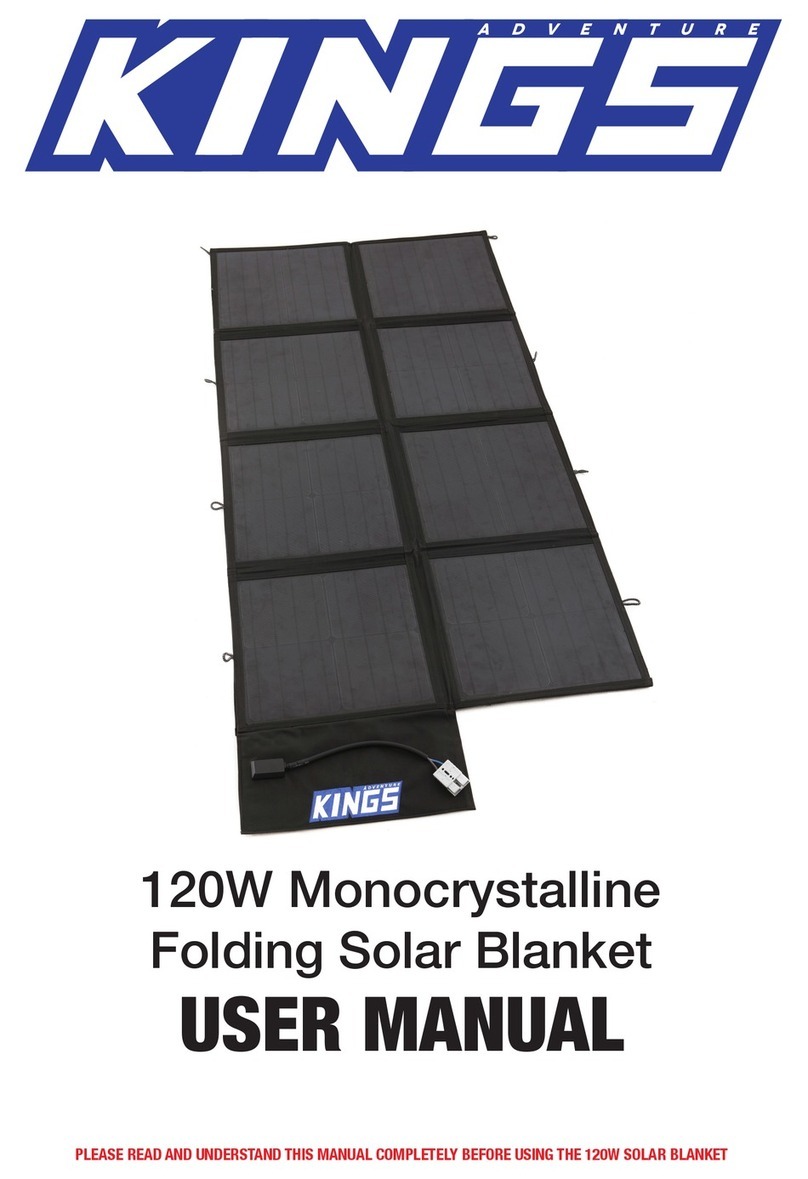
Adventure Kings
Adventure Kings 120W Folding Solar Blanket user manual
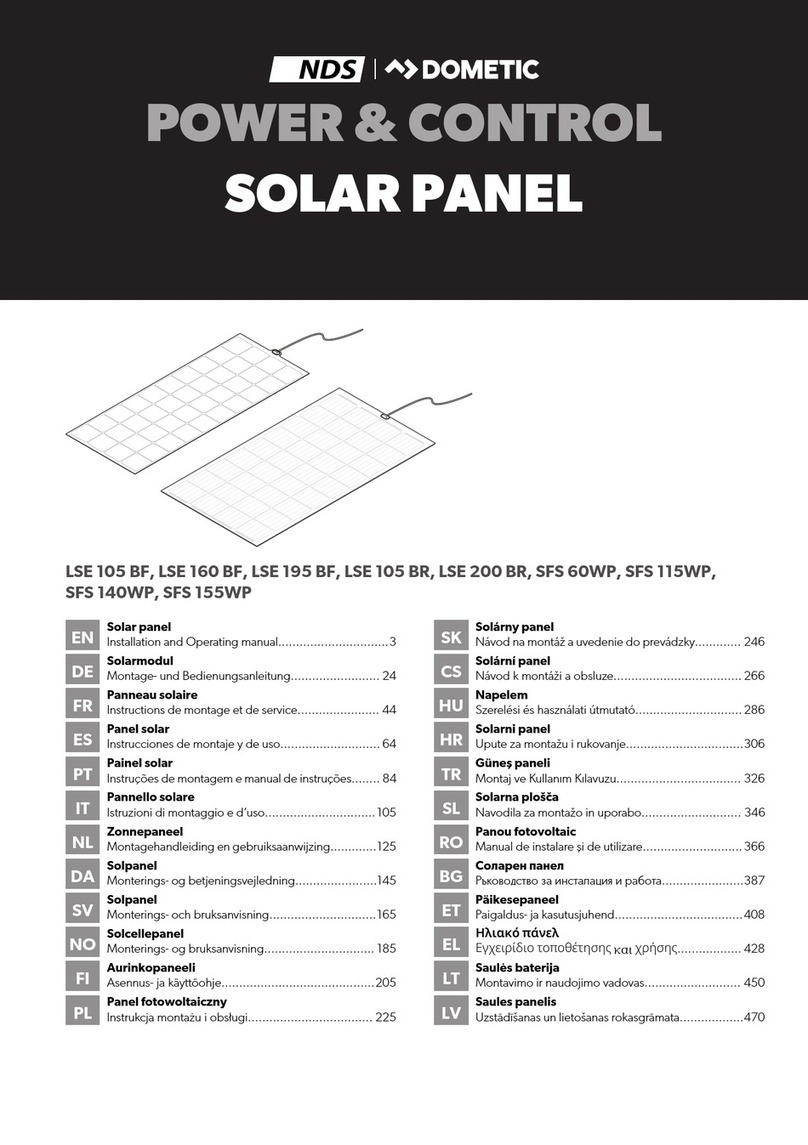
NDS
NDS Dometic LSE 160 BF Installation and operating manual

Viessmann
Viessmann Vitosol 300-T installation instructions
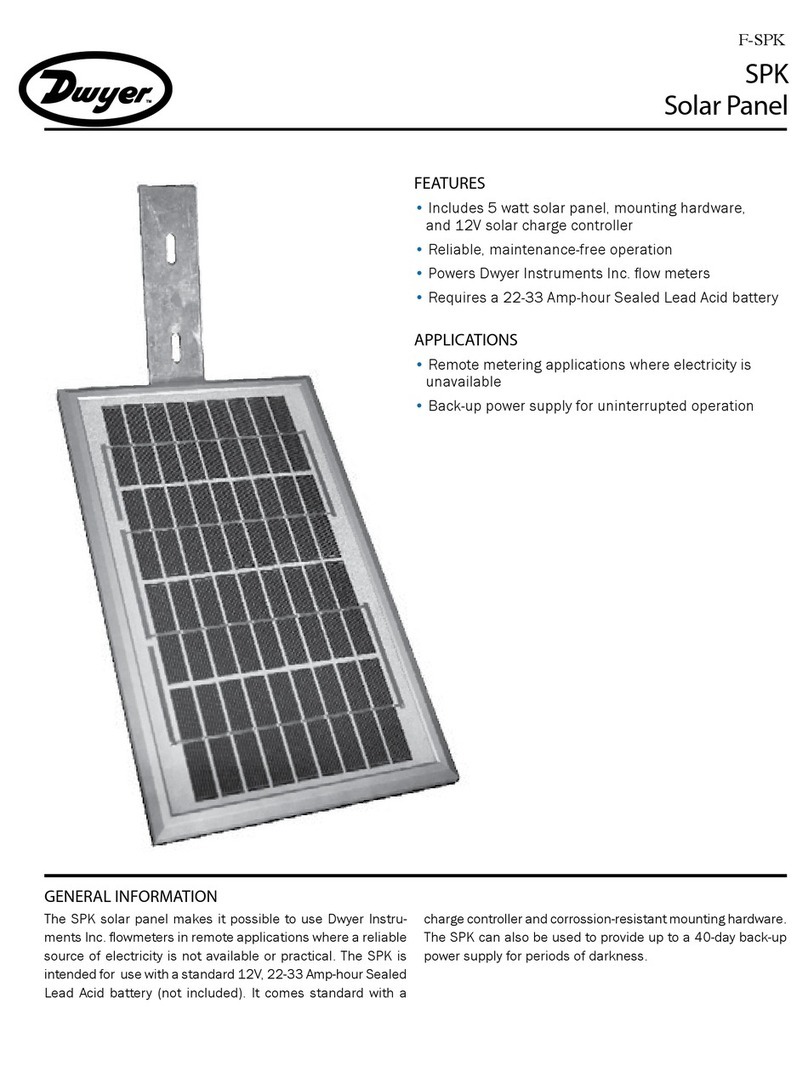
Dwyer Instruments
Dwyer Instruments SPK quick start guide
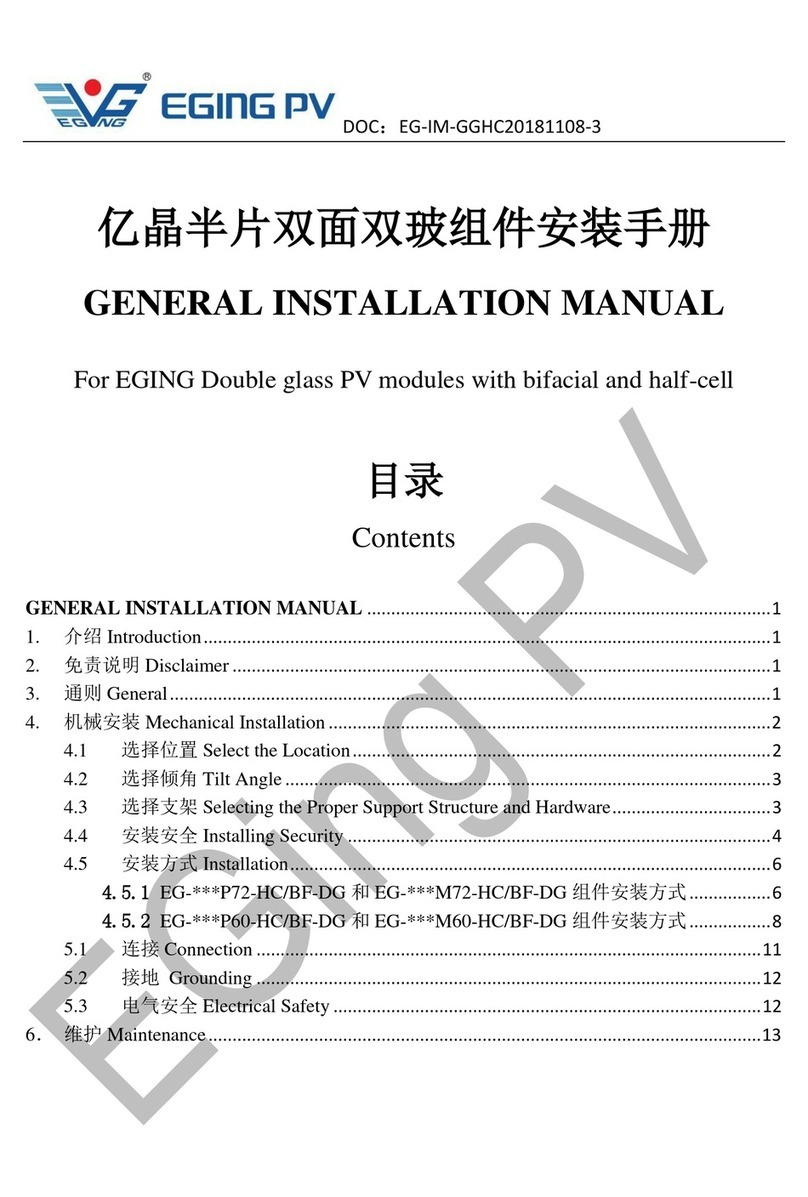
EGING PV
EGING PV EG-P72-HC-DG Series General installation manual
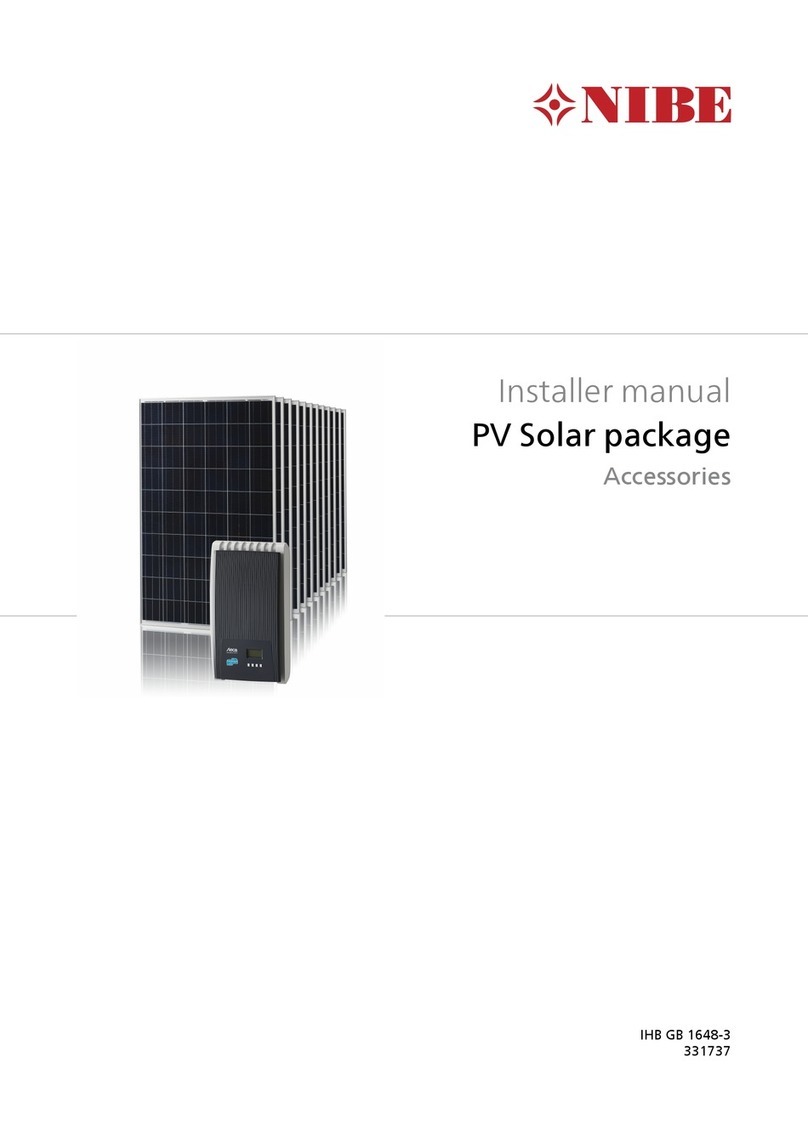
Nibe
Nibe PV Solar package Installer manual
